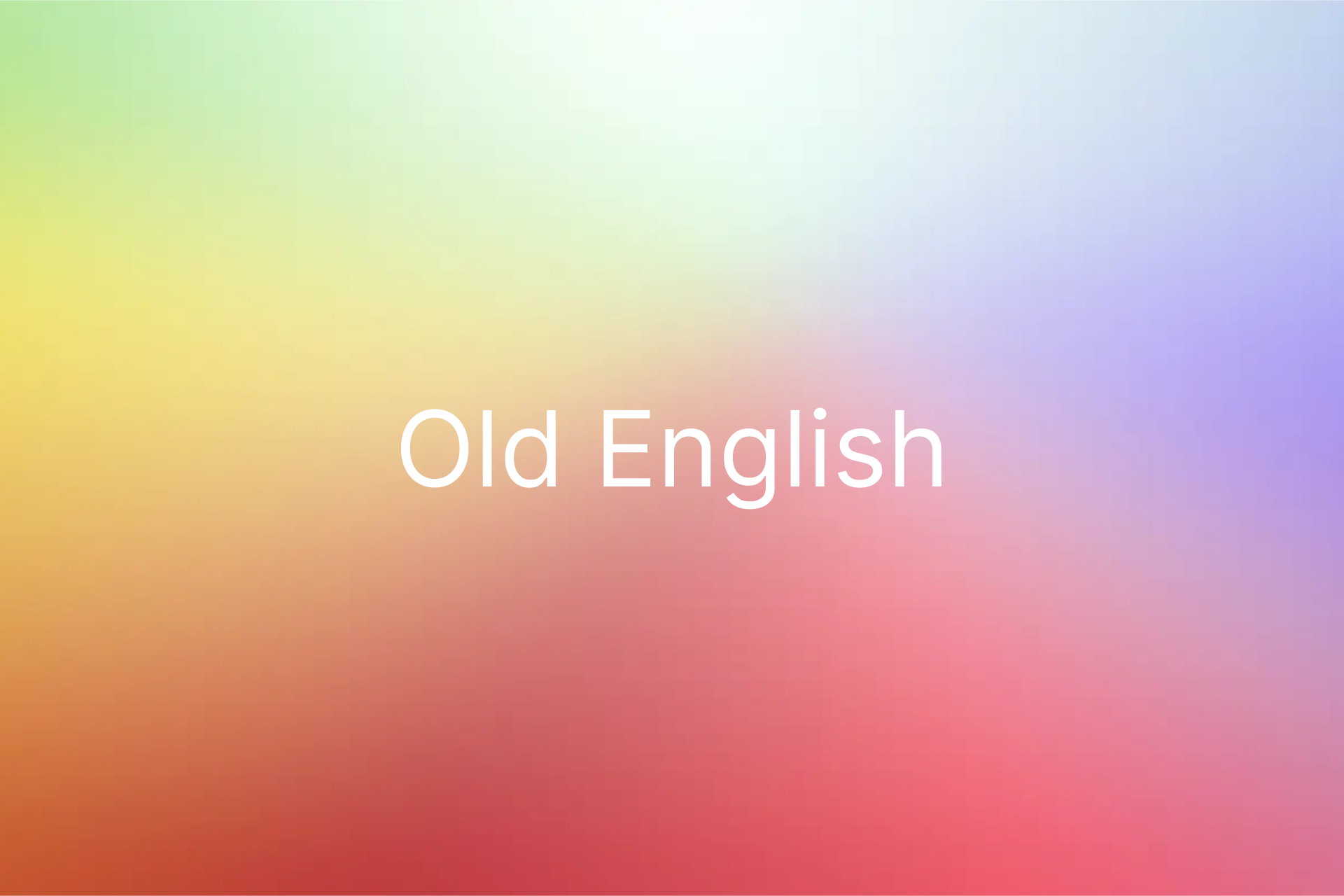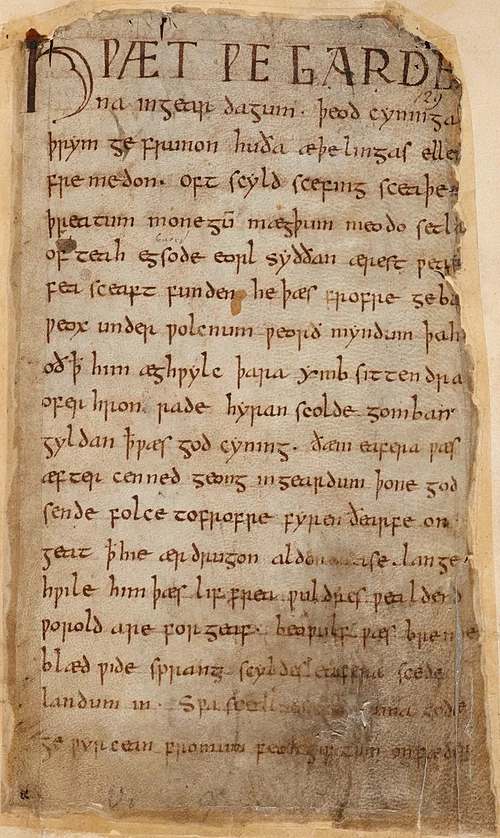Old English: Unlocking the Roots of English

TABLE OF CONTENTS
Key Takeaways
-
Old English, also known as Anglo-Saxon, is the earliest form of English, spoken in England and southeastern Scotland from c. 450 to c. 1150 CE.
-
Brought by Anglo-Saxon settlers, it’s a Germanic language with Latin and Old Norse influences.
-
Its complex grammar and unique vocabulary make it distinct from Modern English.
-
Iconic works like Beowulf offer a window into Anglo-Saxon culture.
What Is Old English?
Ever wondered where English came from? Old English, also called Anglo-Saxon, is the ancestor of the language you’re reading now. Spoken from around 450 to 1150 CE in what’s now England and parts of Scotland, it’s the foundation of Middle and Modern English.
Old English was introduced by Germanic tribes—Angles, Saxons, and Jutes—who migrated to Britain in the 5th century. Their West Germanic dialects evolved into Old English, with some familiar words like “house” (hūs), “bread” (brēad), or “strong” (strang). But don’t be fooled—most of it feels like a foreign language to modern speakers (Quirk & Wrenn, 1957).
Try It Yourself: Can you guess what cyning means? (Hint: It’s a powerful role!) Share your guess in the comments below, and the answer will be revealed later!
A Brief History of Old English
Old English unfolded in three main phases:
-
Early Old English (450–650 CE): Anglo-Saxon settlers arrived, and their language was mostly oral, with few written records.
-
Middle Old English (650–900 CE): Christianity spread, bringing Latin influences. The earliest written texts, like Cædmon’s Hymn (c. 658–680), emerged.
-
Late Old English (900–1150 CE): Viking invasions introduced Old Norse words, especially in the Danelaw region. King Alfred the Great (849–899) championed Old English literature, translating Latin works.
The Norman Conquest of 1066, led by William the Conqueror, marked the shift to Middle English as French became the elite’s language. Yet core words like “house” and “bread” survived, linking us to our linguistic past.
Reader Challenge: Imagine you’re an Anglo-Saxon in 900 CE. What word would you use for “sun”? (Hint: It’s a fundamental word found in many Germanic languages!) Share your thoughts in the comments.
Features of Old English
Old English is a linguistic puzzle with distinct traits:
-
Grammar: It’s highly inflected, meaning words change endings based on case (e.g., subject, object), number (singular, plural), and gender (masculine, feminine, neuter). For example, “king” (cyning) could be cyning (subject), cyninges (possessive), or cyninge (indirect object). Verbs are complex too—take “help” (helpan), with past forms like healp, hulpon, or holpen (Quirk & Wrenn, 1957).
-
Vocabulary: About 85% of Old English words are extinct, but essentials like “house” (hūs) and “strong” (strang) endure. Latin gave us words like “street” (from strata), and Old Norse contributed words like “law” (from lagu).
-
Writing System: Early Anglo-Saxons used runes, as seen on stones like the Ruthwell Cross, but by the 8th century, they adopted the Latin alphabet, adding letters like thorn (þ) and eth (ð) for “th” sounds.

The Ruthwell Cross
Here’s a quick comparison:
| Old English | Modern English | Notes |
|---|---|---|
| hūs | house | Core Germanic vocabulary |
| brēad | bread | Core Germanic vocabulary |
| cyning | king | Core Germanic vocabulary |
| strang | strong | Core Germanic vocabulary |
| strǣt | street | From Latin strata |
| lagu | law | From Old Norse lagu |
Interactive Quiz: Which Old English word do you think is closest to Modern English? Vote in the comments below:
-
A) hūs (house)
-
B) cēac (cake)
-
C) cyning (king)
Old English Literature and Culture
Old English literature is a treasure trove of Anglo-Saxon life. The most famous work, Beowulf, a heroic epic likely composed between the 8th and 11th centuries, survives in a manuscript from around 1000 CE. Here’s a taste of its opening:
Old English: Hwæt! We Gardena in geardagum, þeodcyninga, þrym gefrunon, hu ða æþelingas ellen fremedon.
Modern English: Listen! We have heard of the Danish kings’ glory in days of old, how those nobles performed brave deeds.

A page from the Beowulf manuscript
This snippet shows Old English poetry’s rhythmic, alliterative style and its focus on heroism (Mitchell & Robinson, 2012). Other works include religious texts like King Alfred’s preface to Pastoral Care and fragments like The Battle of Finnesburh.
Engage with History: If you could ask an Anglo-Saxon poet one question about Beowulf, what would it be? Share in the comments for a lively discussion!
Translating Old English Today
Want to try translating Old English yourself? Tools like OpenL Translate make it easier than ever. This AI-powered platform supports translations to and from Old English, handling text, documents, images, and even speech with high accuracy.
It’s perfect for students, researchers, or anyone curious about Anglo-Saxon language. OpenL offers a free tier with 30 daily translations and a Pro plan for unlimited use, plus a 30% discount for students and educators with an .edu email.
Translation Challenge: Head to OpenL Translate, input a simple word like “land,” and see its Old English forms. Share what you find in the comments!
Why Old English Matters Today
Though no longer spoken, Old English lives on in Modern English’s core vocabulary—think “stone” (stān), “wife” (wīf), or “child” (cild). It also connects English to its Germanic cousins, like German and Dutch. Plus, it’s inspired modern works, from J.R.R. Tolkien’s invented languages to historical reenactments.
Fun Fact: There’s even an Old English Wikipedia (ang.wikipedia.org) where you can browse articles written entirely in Old English!
How to Explore Old English
Ready to dive in? Here are some beginner-friendly resources:
-
Translation Tools: Use OpenL Translate for quick, accurate Old English translations across text, documents, and more.
-
Online Courses: Try Old English Online for lessons with audio.
-
Dictionaries: Use the Dictionary of Old English or Bosworth-Toller Anglo-Saxon Dictionary.
-
Books: Peter S. Baker’s Introduction to Old English or A Guide to Old English by Bruce Mitchell and Fred C. Robinson (2012) are great starting points.
-
Thesaurus: Check the Old English Thesaurus for vocabulary exploration.
Final Thoughts
Old English is more than a dusty relic—it’s the root of English and a gateway to understanding our linguistic heritage. From the epic battles of Beowulf to the enduring words we use daily, it’s a fascinating journey. With tools like OpenL Translate, exploring Old English has never been easier. So, grab a resource, try a word or two, and let’s keep the conversation going!
Your Turn: What’s the most surprising thing you learned about Old English? Share it in the comments, and let’s chat!
Answers to Challenges & Quiz:
-
Try It Yourself (What does cyning mean?): cyning means king.
-
Interactive Quiz (Which Old English word is closest to Modern English?): The closest word is A) hūs (house).
Sources:
-
Mitchell, B., & Robinson, F. C. (2012). A Guide to Old English (8th ed.). Wiley-Blackwell.
-
Quirk, R., & Wrenn, C. L. (1957). Old English Grammar. Methuen & Co.


